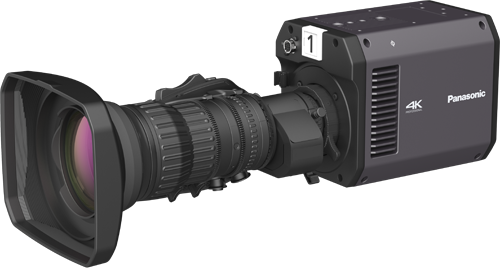- Features the Same Platform as the AK-UCX100 4K Studio Camera
- Achieves 2,000 TV Lines of Horizontal and Vertical Resolution
- Simultaneous HLG (BT.2020) and SDR (BT.709)
- Shorten Time for Color Matching and On-Site Setup with the Unified GUI
- Seamless Integration with Panasonic's System and PTZ Cameras
- Integrated Control/Tally into a Single LAN Line
- Compatible with Multiple IP Transmission Standards
- 4K Redundant Connections
- Moiré Reduction
- Ultra-Lightweight, Flat Design
- Focus Function That Supports High-Level Shooting
Features the Same Platform as the AK-UCX100 4K Studio Camera
Achieves 2,000 TV Lines of Horizontal and Vertical Resolution
The camera’s MOS sensor uses oversampling to achieve 2,000 TVL resolution, both horizontally and vertically, for detailed high-definition reproduction. With F10 (2000 lux) sensitivity and a signal-to-noise ratio of 62 dB or higher, the sensor ensures low-noise, high-quality video even in very low-light conditions.
Simultaneous HLG (BT.2020) and SDR (BT.709)
Hybrid Log Gamma (HLG) achieves fine gradation of light and dark with a wide dynamic range and ITU-R BT.2020 compatibility allows reproduction of nearly all natural colors for superior color accuracy. What’s more, simultaneous use of HLG (BT.2020) and SDR (BT.709) enables optimal color reproduction for virtually any content.
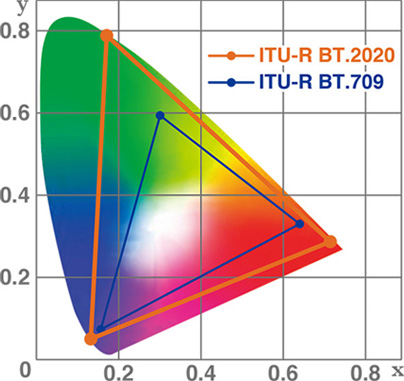
Shorten Time for Color Matching and On-Site Setup with the Unified GUI
The AK-UBX100 utilizes the same platform and shared menu interface as the AK-UCX100. This eliminates the complexity of color matching, which has been a challenge in conventional workflows, and achieves unified operability across different devices.
Seamless Integration with Panasonic's System and PTZ Cameras
The AK-UBX100 connects directly to the same Remote Operation Panel (ROP) used with the AK-UCX100 and AW-UE160.
Since button layouts and menu structures are standardized, operators can switch between models without confusion.
Even in production environments where multiple camera systems are mixed, smooth and efficient operation is ensured.
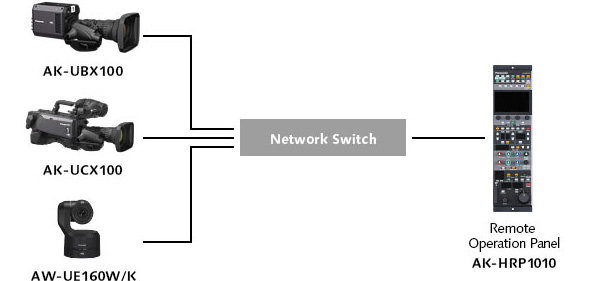
Integrated Control/Tally into a Single LAN Line
Camera control and tally functions are integrated on the same LAN, eliminating the need for GPI or dedicated tally cables. This reduces cable volume, making setup lighter and faster, and lets you easily change layouts, add cameras, or enable remote operation by just configuring the network settings.
Additionally, IP-based functionality allows for log monitoring and batch firmware updates, simplifying system operation even further.
Compatible with Multiple IP Transmission Standards
The AK-UBX100 supports a wide range of IP standards including SMPTE ST 2110, NDI® High Bandwidth, SRT and FreeD*. With SMPTE ST 2110, it also supports network redundancy, ensuring stable 4K IP operations.
- * Only lens information is supported.
4K Redundant Connections
The AK-UBX100 is standard equipped with two SFP+/28 slots and two 12G-SDI outputs. A/B redundant 4K A/B routes can be secured on both optical/IP and baseband lines.
-
SFP+/28 x2 :
Equipped with an optical module, with two optical cables directly connected to the camera head, enabling redundant operation.- *SFP modules are sold separately.
-
12G-SDI x2 :
In addition to sending the same 4K signal to separate routers for backup, these outputs can also be used for simultaneous HDR/SDR or clean/dirty signal output.
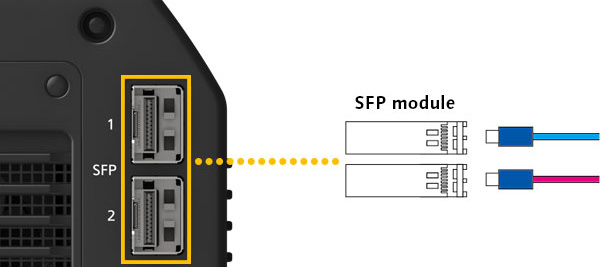
Moiré Reduction
The AK-UBX100 offers two options for moiré reduction.
- Replace the standard UHD optical low-pass filter with an HD optical low-pass filter
Can also be used in combination with the ND filter mounted on the turret. Since the HD optical filter is always active, resolution is slightly reduced.
- Maintain the UHD optical low-pass filter while adding an HD optical low-pass filter to the turret
The standard UHD optical low-pass filter remains in place, while the turret allows you to select either the ND filter or the HD optical low-pass filter. When moiré reduction is required, simply select the HD optical low-pass filter. In this case, it cannot be used in combination with the ND filter.

Without HD optical low-pass filter
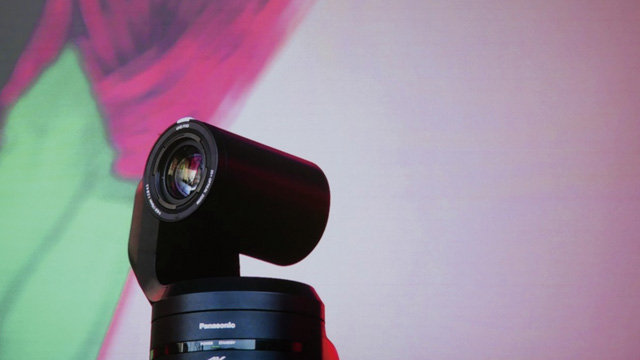
With HD optical low-pass filter
- * Shot under the conditions described in 2, using the AK-UCX100 4K studio camera on the same platform.
Ultra-Lightweight, Flat Design
Compact, Lightweight Approx.1.9 kg Body
With its lightweight and compact design, the camera reduces the need for counterweights even when mounted on gimbals or the tips of cranes. This design also broadens the range of options for lenses, rotators, and other accessories.
Facilitates Setup and Changeover for Robot Mounting
The flat-surface design on all four sides, combined with 1/4-inch screw holes, allows the body to be securely mounted on tripods, gimbals, ceiling rigs, or cranes without the need for tools.
Simply plugging and unplugging cables makes it possible to quickly change orientation or installation location, enabling smooth integration with robotic heads.
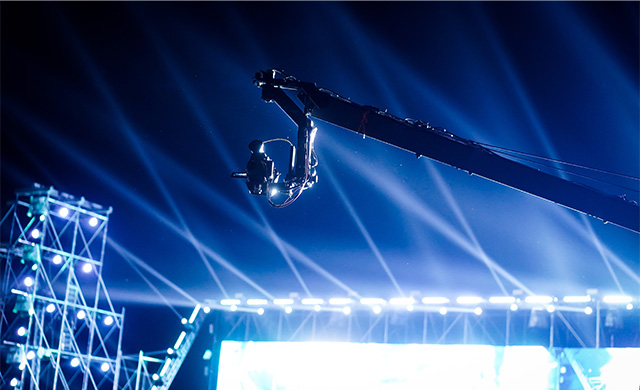
- * The image is for illustrative purposes only.
Focus Function That Supports High-Level Shooting
High-precision focus assist function
The AK-UCX100 is equipped with a high-precision focus indicator that visually guides focus points, along with a focus guide leveraging image-plane phase detection technology to display focus status using intuitive icons. These features enhance usability in live productions where every moment counts. Additionally, VF Shadow Boost enhances visibility by increasing the contrast of darker areas of the viewfinder.
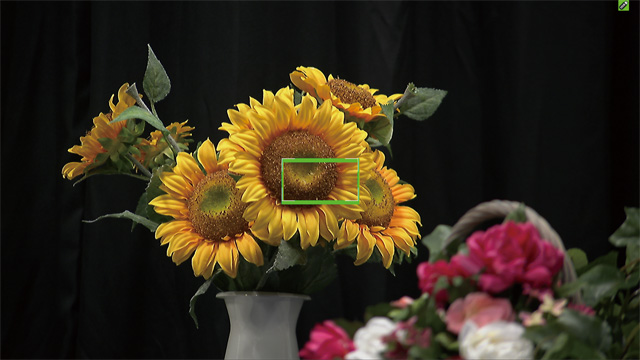
Focus icon turns green when framed subject (background flower) is in focus.
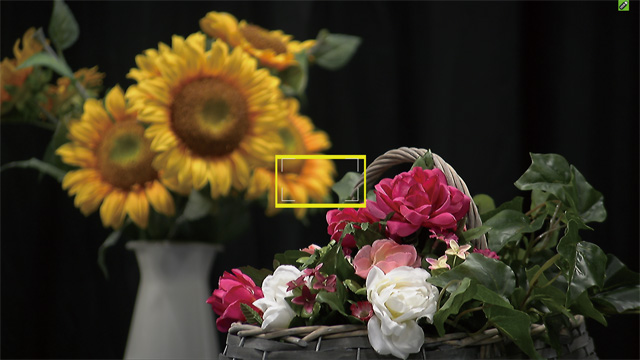
Focus icon turns yellow when you shift the focus to another subject (foreground flowers), causing it to lose focus.

Focus icon turns green when accurate focus is achieved manually.
- * Shot using the AK-UCX100 4K Studio Camera on the same platform.
Autofocus Built into the Camera Head*1
With PDAF (phase detection autofocus), the camera can quickly and reliably focus on subjects regardless of the lens type being used or the operator’s level of experience.
The position, size, and speed of the target area can be adjusted in stages, allowing skilled operators to seamlessly switch to manual fine-tuning whenever necessary.
This ensures precise framing while maintaining creative control.
- *1 Future support planned.
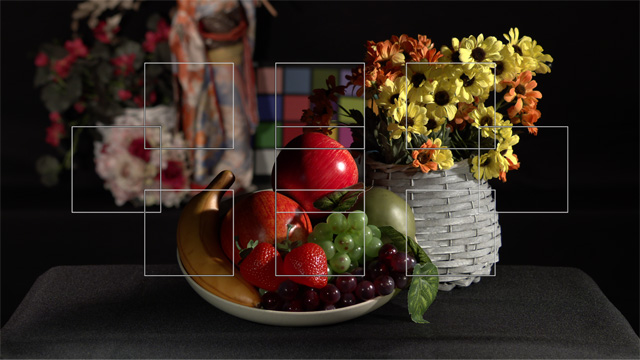
- * With the AF Area Select function, operators can select the target area from nine different areas (only selectable when the area size is set to “Small”).
- * The image shows a screen under development.
Focus area size (selectable in “Large,” “Medium,” or “Small”)
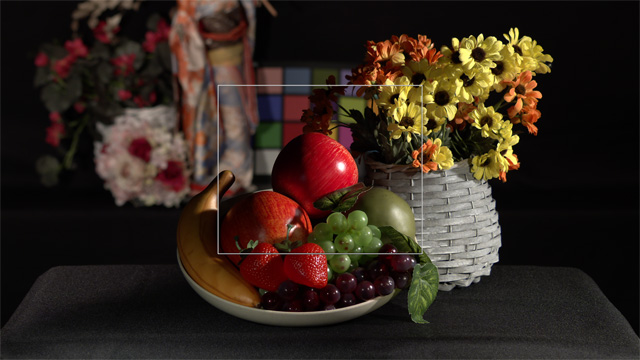
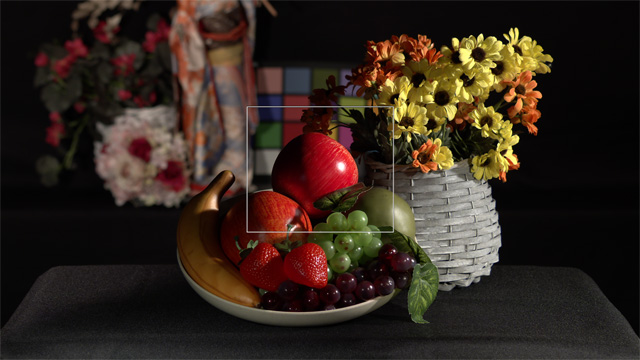
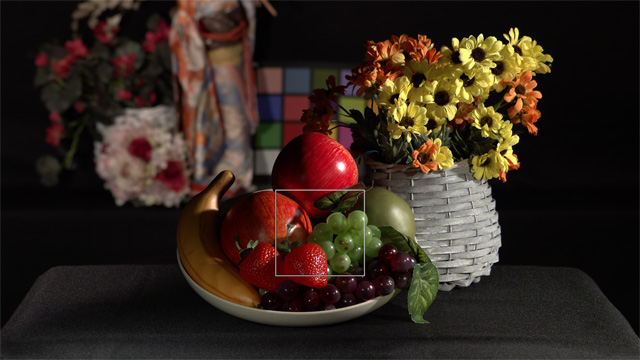
- * The image shows a screen under development.
Mechanism of PDAF (phase detection autofocus)
Light passing through the lens is split into two paths by a mirror and directed to a dedicated distance-measuring sensor, separate from the image sensor. This distance sensor measures the shift (phase difference) between the left and right images.
Because the sensor can calculate both the amount and the direction of this shift simultaneously, the camera can instantly determine how far and in which direction the lens needs to move to achieve focus. This enables high-speed autofocus that drives the lens directly to the point of focus in a single step.


